
21 minute read
2020 – Winter Catalogue
from Jan Muller Art & Antiques
by vecstar
Emile Claus Sint-Eloois-Vijve 1849 – 1924 Astene

Advertisement

◀ The Leye – 1912 h|w 43 x 59,5 cm work Oil on canvas Signed lower left verso: ‘Juny A.B.E.C.’
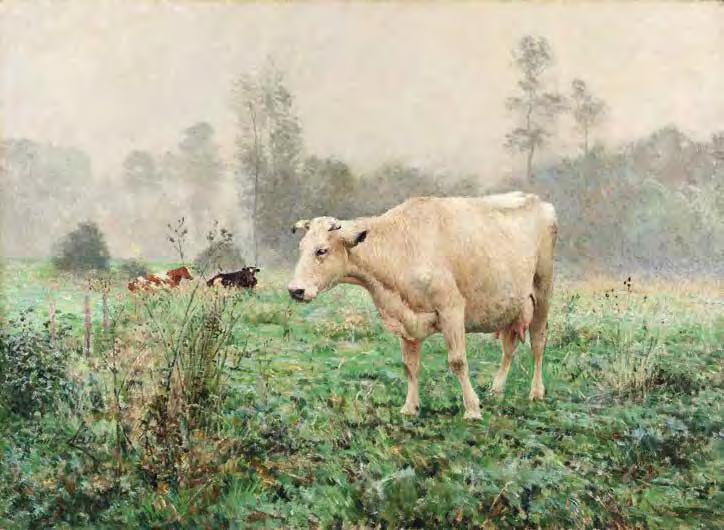
Anna De Weert Gent 1867 – 1950 Gent

Hawthorn snow h|w 51 x 51 cm work Oil on canvas Signed lower right and dated in the back ‘Afsnée mei 1916, 2de oorlogsjaar’
▼ The little peach tree, 1915 h|w 46,5 x 35,5 cm work Oil on canvas Signed right below


Leon De Smet Gent 1881 – 1966 Deurle

Autumn H|w 57,5 x 43 cm
6 work Oil on canvas Signed left below with cartouche ‘LDS 1914’

Albert Saverys Deinze 1886 – 1964 Petegem
Modest Huys Olsene 1874 – 1932 Zulte

work Oil on canvas Signed lower right ‘Modest Huys’ ◀ Autumn H|w 50,5 x 64 cm

Alfons van Beurden junior Antwerp 1878 – 1962 Antwerp
▲ Two women bathing in a river h|w 100 x 130 cm work Oil on canvas Signed lower left ‘van Beurden’ LIterature Arte / Plastische kunst in België, p. 419
▲ Streetview in Paris h|w 40 x 50 cm work Oil on panel Signed lower right

Fernand Toussaint Brussels 1873 – 1956 Elsene
Paul Hermann Wagner Rothenburg 1852 – 1937 Kochel am See
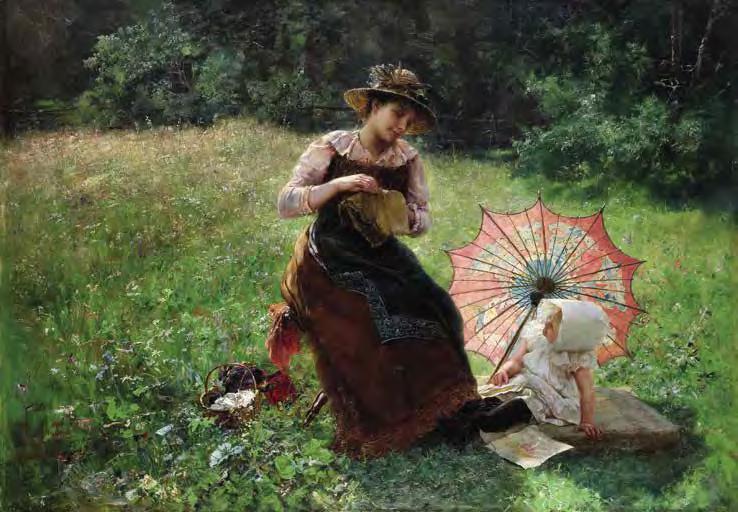
▲ Mother with daughter on a summer’s day H|w 70 x 101 cm work Oil on canvas Signed lower left ‘Paul Wagner München Kochel’
Henri Houben Antwerp 1858 – 1931 Antwerp
This majestic agricultural scene can be seen as a post-impressionist masterpiece in the oeuvre of the Antwerp artist Henri Houben. Houben was educated at the Academy under the direction of Charles Verlat and is known for his portraits, landscapes and genre scenes, for which he found inspiration in the Kempen and Zeeland. In 'Landarbeid' he shows how his work was influenced by the modern developments of late 19th century painting, with Emile Claus' naturalistic impressionism at the forefront. Realism had entered the art of painting since the mid-19th century. Away from the prevailing romantic and classicist ideals of painting, the realistic artists chose scenes from everyday life, which they displayed in large formats. They went to the countryside where they painted reality as they saw her in the open air. In painting, this realism evolved into naturalism, with the aim of painting 'after nature' or, as Zola described it, 'la nature vue à travers un tempérament'. Although daily life seems to be idealized, an objective approach to the rural (or urban) context always prevailed, as a search for the reality of the countryside. In addition, these artists often relied on photographs, which resulted in an even greater objectivity. Certainly in Belgium, the naturalists did not adopt a moralistic attitude: genre pieces in which realism predominated.Through Emile Claus, the figurehead of impressionism in Belgium, the French influences also seeped into the Antwerp painting school in the period 1885-1890,
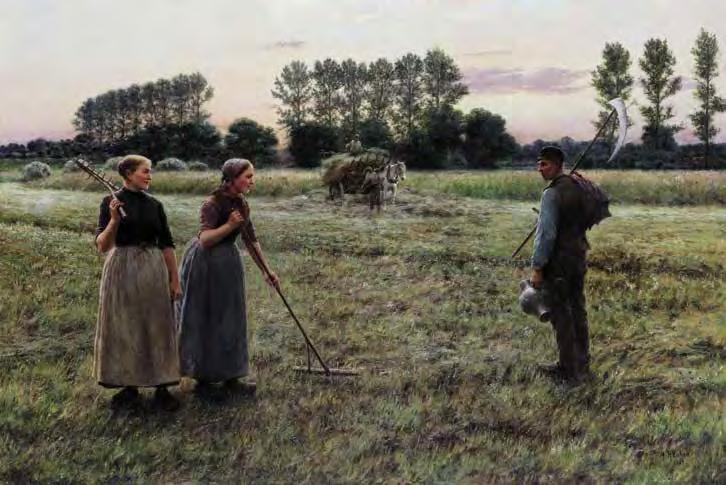
Landarbeid h|w 102 x 149 cm
which at that time was still the most influential in Flanders. Houben must have known Claus, since they lived in the same city for more than ten years, were educated at the same Academy (although with a few years difference) and Claus moved into a studio in Antwerp where he remained until 1889. Early masterpieces by Claus and Vlaswieden in Flanders from 1887 and 'De Bieten' harvest from 1890 are both thematically and stylistically very close to 'Landarbeid' van Houben. Depicted is the reality of the day after work, where the landscape is not a stage piece and the characters are not extras, but people of flesh and blood in their daily environment. The beauty lies in the anecdotal of everyday life. The artist does not want to glorify, but there is a tendency towards monumentization: not only because of the chosen format, but also because of the prominent placement of the characters, full of feet and against a high horizon. Finally, the choice for the time of day, sunset, also fits in perfectly with the spirit of that times, in which experiments with color and light would increasingly determine the new impressionistic visual language. Agricultural labor offers a beautiful tranche de vie from times long gone by now. And yet it is also a modern time document, both stylistically and formally, created in a period in which international trends gave the Antwerp, and by extension Belgian, school of paint a new impetus.

Alfred Stevens Brussels 1823 – 1906 Paris
◀ Watching the moonlight h|w 82 x 60 cm work Oil on canvas Signed lower left ‘Alfred Stevens 84’
Jozef Israels Groningen 1824 – 1911 The Hague
▶ Portrait of a young girl h|w 50,8 x 34,3 cm work Oil on panel Signed lower left provenance Collection of Edward Clarke Cabot, 1818 – 1901

circle of Jan Mertens van Dornicke Antwerp circa 1470 – 1527

▶ A triptych: The adoration of the Magi, The Nativity and The flight into Egypt h|w 80 x 114 cm open work Oil on panel provenance Douwes, Amsterdam 1984

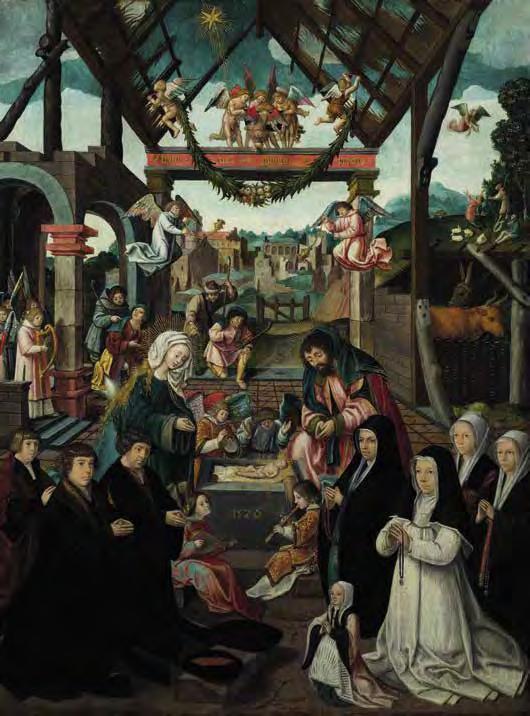
attributed to Dirk Jacobsz Amsterdam 1496 – 1567
and the studio of Jacob Cornelisz van Oostsanen Oostsanen before 1470 – 1533 Amsterdam
Dirk Jacobsz was probably born in Amsterdam circa 1496/7 and buried there on September 9, 1567. His father acquired a house in Amsterdam in 1500. He was a pupil and later a collaborator of his father Jacob Cornelisz. Van Oostsanen, who’s workshop he inherited after the latter’s death in 1533. He married Marritgen Gerritzsdr, which whom he had two children. While his father’s studio was specialized in religious history paintings, Dirk became a renowned portrait painter in Amsterdam. In his early years he was also influenced by the draftmanship, color and painting strategy of his lifetime friend Jan van Scorel (1498-1562), who was also a pupil of Jacob Cornelisz. Van Oostsanen. Some ‘Schutterstukken’ for corporations are extant in the Amsterdam townhall (dated 1556), the Rijksmuseum (dated 1529, another 1563) and the Hermitage (dated 1532, another dated 1561). The well-drawn hands and dynamic attitudes of the figures by Dirk Jacobsz. differentiate him of van Scorel. Jacob Cornelisz van Oostsanen ran a successful studio with a great number of assistants. It allowed him and his studio to produce many smaller devotion pieces after his prestigious ‘standard models’. The nativity scene in the present painting is such a serial studio product. It repeats a great many of elements after the artist’s Adoration of the Shepherds, dated 1512 (Museo Nazionale di Capodimonte, Napels). Many versions with variations of this scene exist, all done in collaboration with skilled assistants. Sotheby’s Parke Bennet New York sold December 2, 1976 such a version in which Adriaan Isenbrant collaborated (panel 97,5 x 75,5 cm, Friedländer nr 254). The portraits of the donors in the present painting are of a fine execution, allowing in the present author’s opinion an attribution to the young Dirk Jacobsz, active in his father’s workschop. The hands, the folds in the cloths are well painted The facial expression of each of the eight members of this family is sensitive. The painting style is still somewhat reminiscent of that of his friend van Scorel. All stylistic the elements in this painting are in accordance with the date on the stone cradle: 1526. — Text by Prof. Dr. Jan De Maere
The Adoration of the shepherds with donors h|w 73 x 55,3 cm work Oil on panel Dated 1526 central panel
provenance • collection Compte de Fursac, Brussels • 1923. Brussels as Thierry Cornelisz. • The Ehrich Galleries, New York • collection Nico Cevat, Amsterdam • collection José Fernández, Madrid • collection Juan A. Maragall, Barcelona
Frans I Pourbus Bruges 1545 – 1581 Antwerp
▶ Portrait of a woman with a lace ruff H|w 38 x 27 cm work Oil on panel We thank Dr. Koenraad Jonckheere for this attribution after inspection of the original.


Flemish school,probably Ghent, circa 1500 The adoration
h|w 41 x 32 cm work Oil on panel

attributed to Willem Benson Bruges 1521 – Middelburg 1574 Virgin and Child with angel and bowl of cherries
h|w 79 x 66,5 cm work Oil on panel
Jan Rombouts the Younger Leuven c. 1505 – 1559 Leuven
▶ Susanna and the Elders h|w 105 x 134,5 cm work Oil on panel Signed and dated with monogram IRO lower right 1543 Expertise by Dr. Jan de Maere, 2019
He was the son , pupil and collaborator of Jan Rombouts the Elder (Louvain c. 1480-1535). His father, listed in Louvain as ‘Johannes Rombouts pictor’, is the grandnephew of the Louvain glasspainter Claes Rombouts. Jan the Elder 1 was dean of the Louvain city administration from 1519 until his death in 1535 and served as one of the governors of an Antonine chapel 2 . He married Barbele Roelants with whom he had two children. Their daughter Marie married Jan Willems, a painter in Louvain. Jan the Younger worked in his father’s workshop and later as an independent free master in Louvain, where he held public offices and served as alderman of the painters guild. Both father and son were painters and glass painters. Their complex and colorful compositions, inspired by the Antwerp Romanists and Italianate examples of pseudo-Renaissance architectural elements, introduced in their home town the stylistic innovations realized by Albrecht Durer, Lucas van Leyden and Bernard van Orley. The father was more restrained in his draftsmanship and closer to the Renaissance style, as we see in his wing ‘Saint Margaret of Antiocha’ of the monogrammed altarpiece ‘The Conversion of Saint Paul’ in the M-museum Louvain, His son was more extravagant in an exuberant mannerist style, as seen in the present painting. This ‘Susanna and the Elders’ is an important discovery for early Mannerist painting in Louvain in the first part of the sixteenth century. In the nineteenth century, the city archivist of Louvain Edward van Even read the monogram of the works of Jan Rombouts the elder as ‘IVR’, wrongly identifying the author as the Louvain painter Jan van Rillaer. The latter was only born in 1520/25. Therefore it is obvious that it is in fact the monogram of Jan Rombouts the Elder , active and documented as a free master already in 1520-1525. — Text by Prof. Dr. Jan De Maere

1 Dan Ewing, Review of Uvette Bruynen, Jan Rombouts: The Discovery of an
Early Sixteenth-Century Master in Louvain, Ars Nova 16, Brepols Turnhout 2011, Historians of Netherlandisch Art, vol 30, nr 2, November 2013, pp 35-36. http://hnanews.org/hnar/jan-rombouts-discovery-early-sixteenth-centurymaster-Louvain-ars-nova-16
2 Jan Rombouts I: RKD files: http://explore.rkd.nl/artists/67879
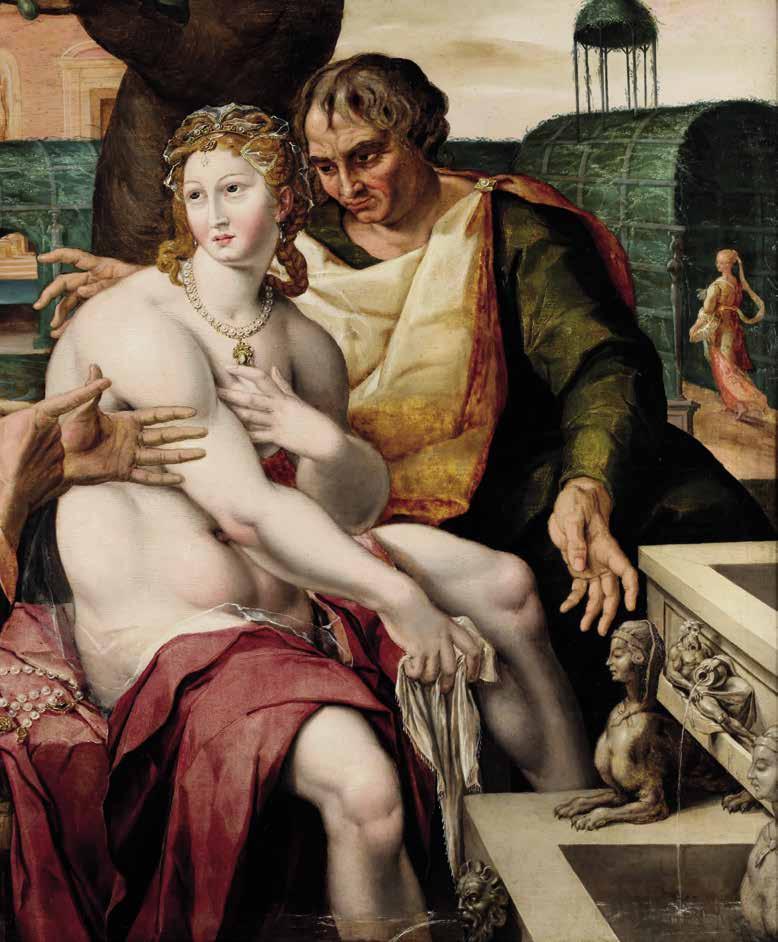
Adriaen van Stalbemt Antwerp 1580 – 1662 Antwerp
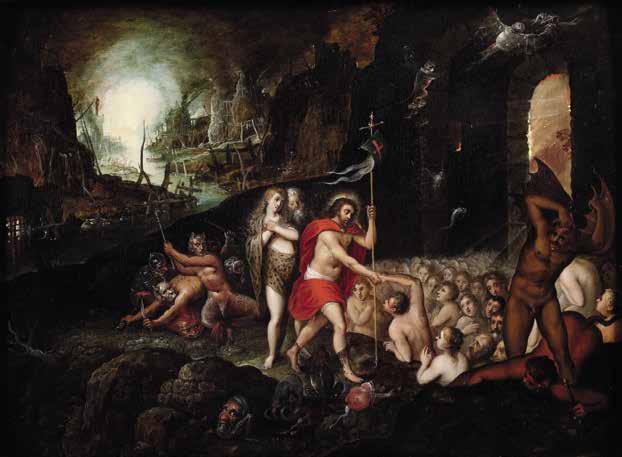
▲ Descent of Christ into hell h|w 34 x 47 work Oil on panel provenance • International Art Center of Roerich Museum, New York (as Jan Brueghel and Rottenhammer) • Noortman and Brod Gallery London 1982 as Jan Brueghel the younger • certified by Dr. Ertz, 2018 literature • Jan Brueghel II cat. 136 • Adriaen van Stalbemt p. 414 add. 7 to be dated during the 1620’s
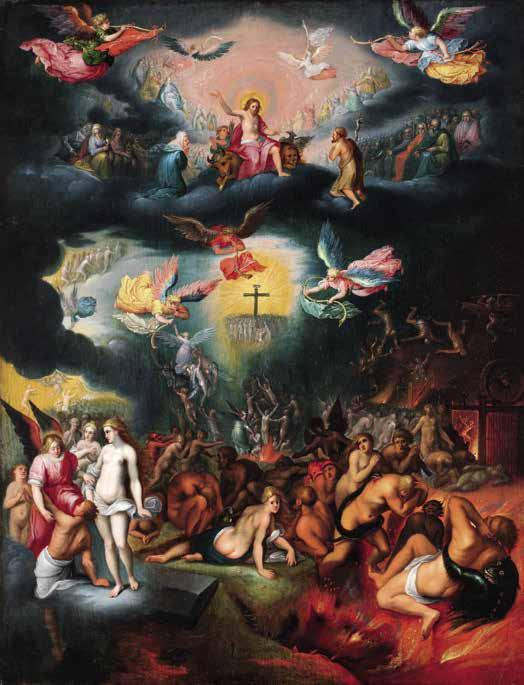
Flemish school, 17th century The last judgement
h|w 53,5 x 40,5 cm
work Oil on panel

Pieter Claeissens the Younger & Antoon Claeissens 1500 – 1576 Bruges & 1536 – 1613 Bruges
▲ The banquet of the gods h|w 37,6 x 47,2 cm work Oil on copper Signed lower left

▼ Portrait of Charles V at the age of 44 h|w Ø 44 cm work Oil on panel
circle of Bartholomäus Bruyn Cologne 1494 – 1555

attributed to Jacob Bouttats Antwerp, before 1660 – c. 1700
▲ Noah and his family entering the ark together with the animals
26 h|w 39,5 x 50 cm
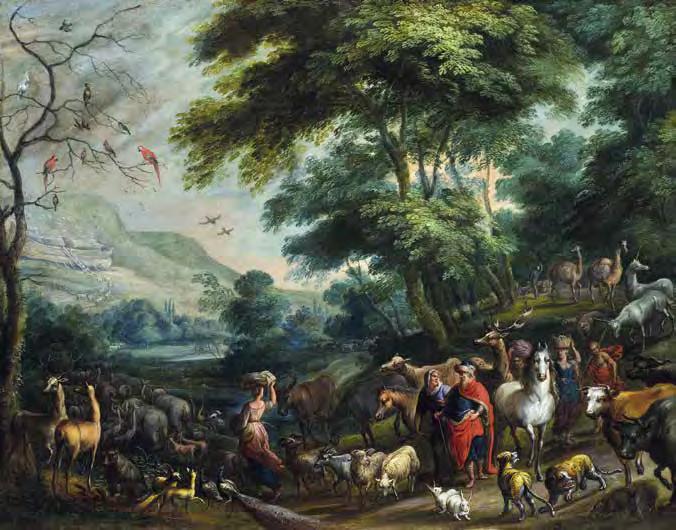
work Oil on copper

Roelandt Savery Courtrai 1576 – 1639 Utrecht
A horse in a landscape h|w 17 x 25 cm work Oil on panel Signed right above
David Vinckboons Antwerp 1601 – 1677
We are gratefull to Dr. Klaus Ertz and to Dr. Ursula Härting for confirming the attribution of the present painting to David Vinckboons. He dates it in the early years of the artist, circa 1605.
David Vinckboons’ painted oeuvre, for which the first catalogue was compiled by Korneel Goossens in 1954 and for which K. Ertz and C. Nitze-Ertz published a new one in 2016, consists mostly of histories and genre scenes in landscape settings. The style, composition and light heartedness of these works recall Flemish painting of the 16th century, albeit in a less overtly moralising manner.
The present composition with its turbaned figure in the foreground may allude to a biblical setting. The figure is shown leading a small boy and the presence of a flock of lambs, with their sacrificial connotations, may allude to The Binding of Isaac. David Vinckboons was born into a family of artists in Malines in 1576. His grandfather Gillis had settled there in 1489 and had opened a studio of painting in watercolour on canvas – a Malines specialty continued by his son Philip (1545–1601). Due to the political and religious situation of the day, Philip moved his business to Antwerp in 1579, where he is recorded from 1580 until 1586. As the situation deteriorated for the reformed community to which the Vinckboons belonged, in late 1586 Philip travelled to the North with 185 other Antwerp families under safe conduct granted by the Duke of Leicester.
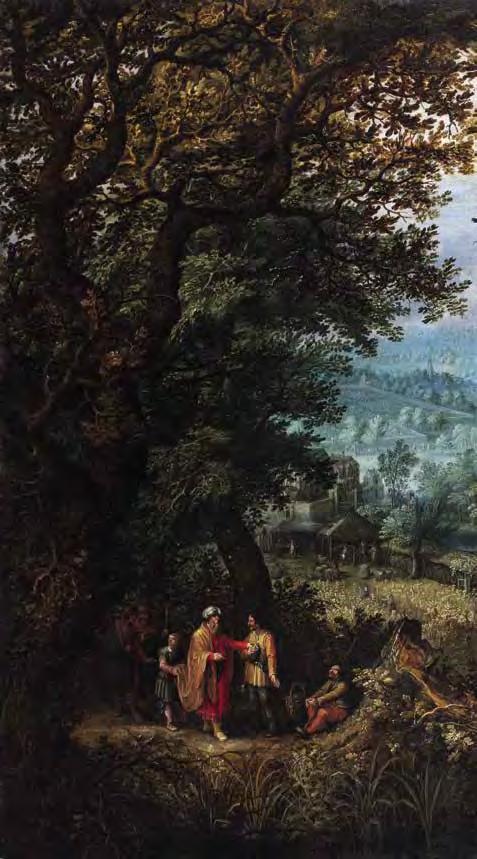
Here he first settled in Middelburg and from 1591 in Amsterdam. With other religious immigrants from the South, such as Gillis van Coninxloo and Hans Bol, the Vinckboons family formed a tight artistic community in Amsterdam and continued their businesses as before. Thus David received his training from his father and first specialised in paintings in watercolour on canvas, such as his forebears had done. Later he took up painting in oil, mostly on smaller formats, which Karel van Mander praises as having considerable merit. His compositions must have been popular since they were frequently engraved.
▶ An extensive wooded landscape with biblical staffage h|w 111 x 170 cm work Oil on canvas Accompanied by a written certificate by Dr. Ertz (March 2019) and also by a written certificate of Dr. Ursula Härting (January 2020)

Jan Breughel the Younger Antwerp 1601 – 1677
▼ A village scene
H|w 45 x 73 cm
work Oil on panel authenticity issued by Dr. Luuk Pijl, 12 June 2018, certificate nr VII8/377
Jan Brueghel the Younger was born in Antwerp in 1601 and being Jan Brueghel the Elder’s first child he must have felt his destiny to continue the artistic tradition of his family very strongly. He started to work in his father’s workshop at the tender age of ten. As his father had done in the 1590’s, he went to Italy, in 1621. In Milan he stayed with Cardinal Federico Borromeo, who was arguably the most important patron to his father. He went as far as Sicily where he is documented in 1623 and 1624. In Palermo he spent much time with his friend Antony van Dyck, who was two years his senior. Early 1625 he learned of the death of his father and three brothers and sisters, all whom had been victim to a cholera epidemic raging in Antwerp. Jan set out for home instantly but the journey took much longer than expected. By August 1625 he felt the responsibility of
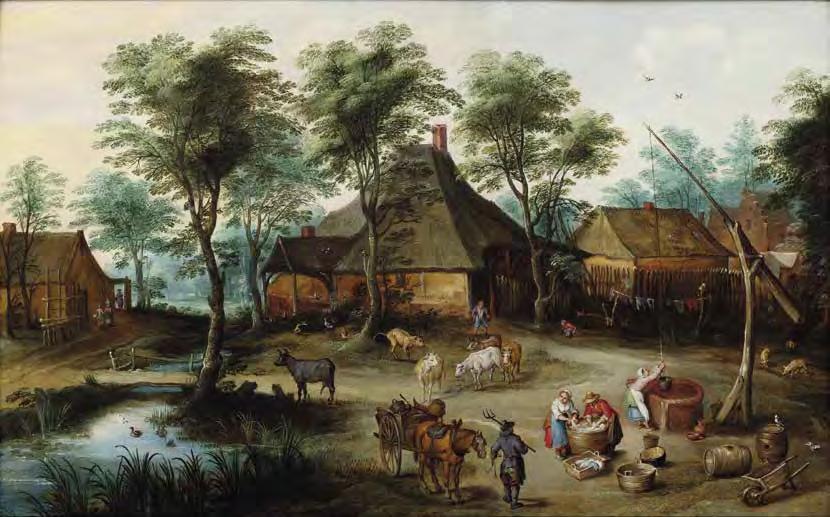
being the head of a large family. Successfully he sold paintings made by his father and also completed unfinished works in order to sell them. He took over his father’s studio with his contacts throughout Europe. In the same year he became a master in the St Lucas Guild and during the season 1630-31 he was even head of this institution. He managed to secure important assignments for the French Royal house and the Austrian Court. In 1626 he married Anna Janssens daughter of the well-known history painter Abraham Janssens. The couple were to have no less than eleven children. We are luckily well informed about his Italian trip, his personal life, his financial affairs and his social life since his journal, which ends in 1651, is being preserved. He died in Antwerp in 1678 at the age of 77. →
The painting under discussion is known through a handful versions, almost identical in seize (Klaus Ertz, Josse de Momper der Jüngere, Freren 1986, pp. 392-95). Two versions (Ertz 1986, op cit, cat. nos. 380 and 381) show in the front a cart pulled by a horse which is omitted in the present version. A version in the Louvre in Paris also omits the cart (Jacques Foucart, Catalogue des flamands et hollandaises du musée du Louvre, Paris 2009, p. 109). Ertz attributes the landscape parts of this small group to Joos the Momper, but they should be given on stylistic grounds to Jan Brueghel the Younger, as did Jacques Foucart in his excellent catalogue of the Dutch and Flemish painting in the Louvre (vidi sopra). The present version is outstanding in terms of condition, color and modeling of the figures. A drawing recorded in Russia (Ertz 1986, op. cit, p. 395, fig. 502) shows a very similar composition. It seems that this drawing, which omits the simple wooden bridge, is copied after one of the paintings and that it played no part in the creative process leading to one of the painted versions. It is remarkable how very few drawings, that were used as aids in the daily studio practice, have survived from the several Brueghel workshops. Being not considered works of art in own right, most of them are now lost. The composition is Jan Brueghel the Younger´s own invention, it does not rely on a painting or drawing by his father. A date during the late 1630´s seems most likely in the light of the master´s stylistic development. This fine and original composition provides a beautiful glimpse into rural life in seventeenth century in Flanders. To the best of my knowledge and in good faith, I remain, Dokkum, The Netherlands, May 7th 2019 — Text by Dr. Luuk Pijl, 2019


Jan Brueghel the Younger Brussels 1601 – 1678 Antwerp
▲ Village scene with a drift of pigs H|w 5,8 x 7,4 cm work Oil on copper Expertise present by Dr. Luuk Pijl, 2019
The present, miniature like, oval on copper shows a village street with a herdsman directing a drift of pigs. In the middle distance three carts are parked in front of an inn. A couple is leaving the inn, while a rider on horseback, accompanied by a footman, is entering the scene from the far distance. This fine and original composition provides a beautiful glimpse into rural life in seventeenth century in Flanders. The details and the colorful palette provide the image with a sparkling presence. The paint is preserved very well, allowing us to enjoy the beautifully painted details, especially in the figures and the rendition of the foliage of the trees. Also the sky is in fine condition, it imbues the landscape with great transparency. The composition is clearly inspired by the works of Jan Brueghel the Elder, but no drawn or painted prototype by the elder Brueghel is extant. Shortly after his return from Italy Jan junior worked in a style strongly reminiscent of his father. Therefore the present work should be dated between 1625 and 1630. Not a single work made by Jan the Younger from his Italian period is known today. During the second part of the 1620’s and the early 1630’s he worked strongly in his father’s highly detailed style catering the strong demand for these type of works. From the early 1640’s onwards Jan started to use a more personal manner as can be seen in the so called Adam cycle, a series made on large copper plates which he painted for the French Royals. To the best of my knowledge and in good faith, I remain, Dokkum, The Netherlands, 19 November 2019 — Text by Dr. Luuk Pijl, 2020
Marten Ryckaert Antwerp 1587 – 1631 Antwerp

Marten Ryckaert was certainly the most important master in Antwerp to cater the strong demand for Paul Bril- and Jan Brueghel-like landscapes. He learned with Tobias Verhaeght, who was also the master of Rubens and Josse the Momper. It has often been stated that Ryckaert travelled to Italy around 1605-10, but no such trip is documented. The assumption that he travelled south bound comes from his emulation of the work of Paul Bril, who worked in Rome for more than five decades. However, Paul Bril´s paintings were present in Antwerp collections early on and Ryckaert could have studied Bril´s work in his native town. Ryckaert was registered in the Antwerp guild of Saint Luke in 1611 as 'the painter with one arm'. Despite this handicap he was highly prolific and gained a solid reputation for his landscapes with ruins, mountains, waterfalls and pleasant valleys. Anthony van Dyck painted his impressive portrait, today in the Prado in Madrid.
The present set of paintings are showing a landscape with Christ on his way to Emmaus and a landscape with three watermills omitting religious content. The lion share of Marten Ryckaert’s output is dependent on inventions by Paul Bril and Jan Brueghel the Elder. However, the compositions of the present paintings are dependent on the inventions of Tobias Verhaeght and Joos de Momper, both never worked on copper support and in oil on such a small scale. Not just the general layout, but also the way the architecture – such as the watermills, bridges, houses, castle and church – is included in the scenery is especially inspired by the works of De Momper. Furthermore the color scheme, with bright greens and blues, derives from the older master´s paintings.
These fine and well preserved paintings are fully executed in Marten Ryckaert´s characteristic handling, with strong local colors and dot-like high lights. A date of execution around 1620 is feasible for these works.
To the best of my knowledge and in good faith, I remain, Dokkum, The Netherlands, January 2nd 2020 — Text by Dr. Luuk Pijl, 2020

▼ Landscape with three watermills h|w 18 x 23 cm work Oil on copper
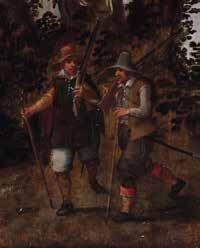
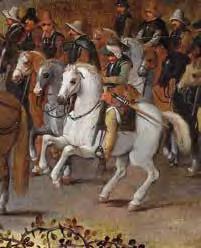
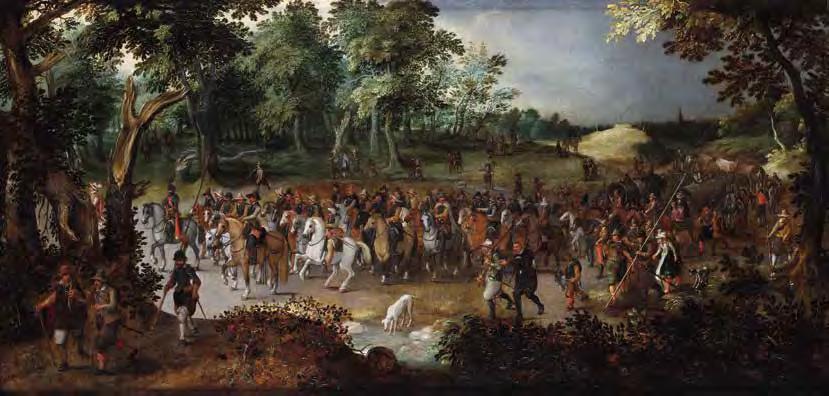
Sebastiaen Vrancx Antwerp 1573 – 1647 Antwerp The passage of the army troops
▲ h|w 50 x 81,5 cm work Oil on panel
Sebastiaen Vrancx Antwerp 1573 – 1647 Antwerp
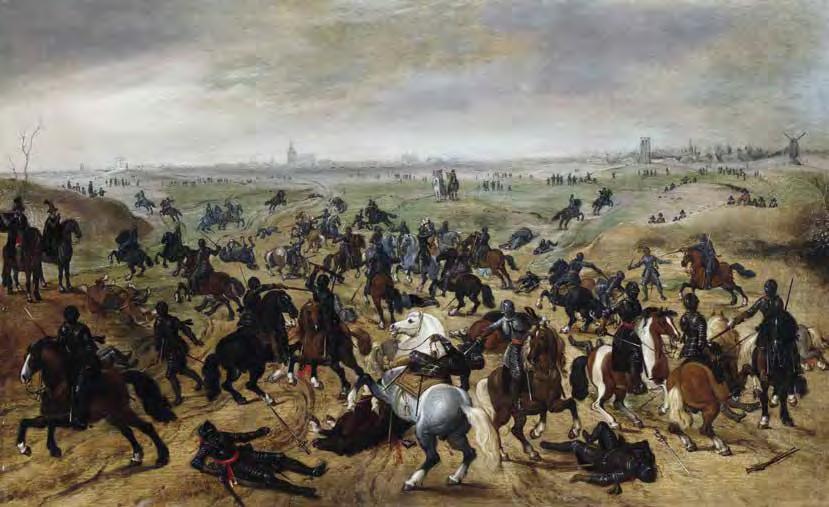
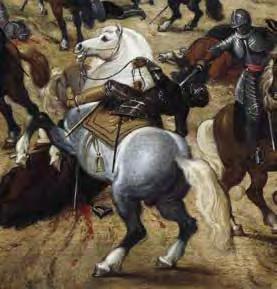
▲ The battle of Lekkerbeetje at Vught, 5 February 1600. h|w 50 x 81,5 cm work Oil on panel
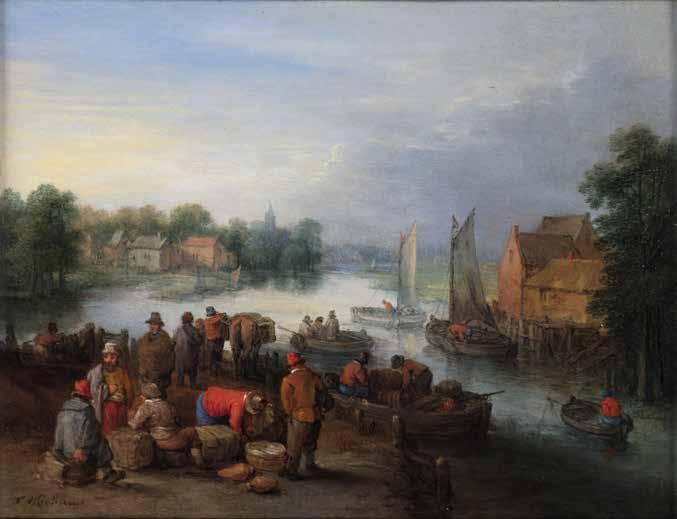
Théobald Michau Doornik 1676 – 1765 Antwerp
▲ Tradesmen along a river h|w 17 x 24 cm work Oil on copper Signed lower left
Gerard Thomas Antwerp 1663 – 1721 Antwerp
▼ The workshop of a sculptor h|w 68 x 85 cm work Oil on canvas


